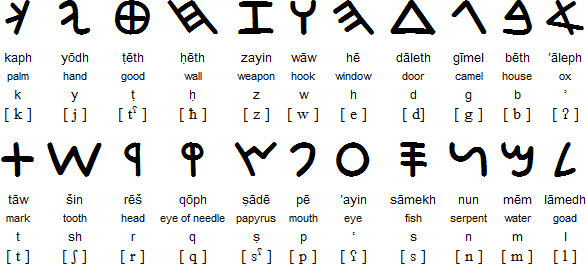It looks like you're using an Ad Blocker.
Please white-list or disable AboveTopSecret.com in your ad-blocking tool.
Thank you.
Some features of ATS will be disabled while you continue to use an ad-blocker.
share:
If "pava" (Latin for peahen, female peacock) is indeed written on it, it would make sense because the peacock is very symbolic across many cultures.
en.wikipedia.org...
Mod Note: Excessive Quoting – Please Review This Link
Quoting External Sources - Please Review This Link
en.wikipedia.org...
In Hinduism, the Peacock is associated with Saraswati, a deity representing benevolence, patience, kindness, compassion and knowledge. Peacock is also the mount of Hindu God of war Murugan. The peacock is the steed of Kartikay, the brother of Ganesha. Similar to Saraswati, the Peacock is associated with Kwan-yin in Asian spirituality. Kwan-yin (or Quan Yin) is also an emblem of love, compassionate watchfulness, good-will, nurturing, and kind-heartedness. Legend tells us she chose to remain a mortal even though she could be immortal because she wished to stay behind and aid humanity in their spiritual evolution.
In Greco-Roman mythology the Peacock is identified with the goddess Hera (Juno). The eyes upon the peacock's tail comes from Argus whose hundred eyes were placed upon the peacock's feathers by the goddess in memory of his role as the guard of Io, a lover of Zeus that Hera had punished. The eyes are said to symbolize the vault of heaven and the "eyes" of the stars.
In Babylonia and Persia the Peacock is seen as a guardian to royalty, and is often seen in engravings upon the thrones of royalty.
In Christianity, the peacock is an ancient symbol of eternal life. The Peacock symbolism represents the "all-seeing" church, along with the holiness and sanctity associated with it. Additionally, the Peacock represents resurrection, renewal and immortality within the spiritual teachings of Christianity. Themes of renewal are also linked to alchemical traditions to, as many schools of thought compare the resurrecting phoenix to the modern-day Peacock.
edit on 1-12-2011 by Mercurio because: (no reason given)
edit on 1-12-2011 by Mercurio because: (no reason
given)
edit on 1-12-2011 by Mercurio because: (no reason given)
Quoting External Sources - Please Review This Link
edit on Thu
Dec 1 2011 by Jbird because: (no reason given)
Originally posted by IAMTAT
Hello,
My Brother-in-Law (ArcAngel) posted this for me this morning while he was visiting (He is currently en route home).
Many of you have asked for morE details regarding this object; here is what I know:
The piece is Granite or Basalt. It was purchased through an antiquities dealer in New York, representing a private Austrian collection. I was told that it was originally unearthed from an early dig in Cheresones (Crimea) and that it might be some form of Greek or early Etruscan. My personal belief is that it's symbols may possibly be alchemical in nature (as some have already suggested). What is not present in the two photographs ArcAngel sent, are the additional glyphs/symbols which circuit the outer rim of this artifact...these are similar to those present on the top and bottom. -TAT
I should have read this post before going on my post-a-thon assuming it was from Britain. I thought that because the UK was mentioned in the original post.
But still , there has to be something to "PAVA". The Gothic alphabet didn't have a letter that looked like P or V.
edit on 1-12-2011 by
Mercurio because: (no reason given)
reply to post by Druid42
Thanks for your patience. As requested...here are some additional photos of the characters along the side (rim) of this bowl. I hope this helps. -TAT
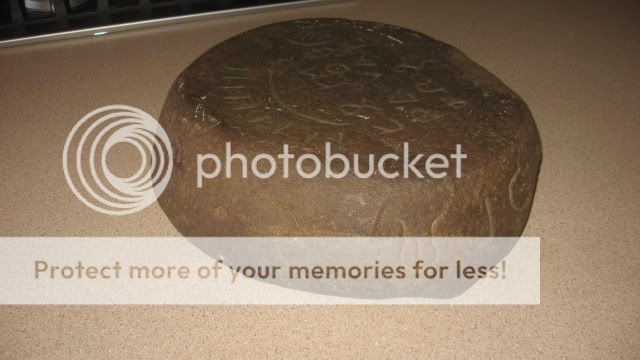

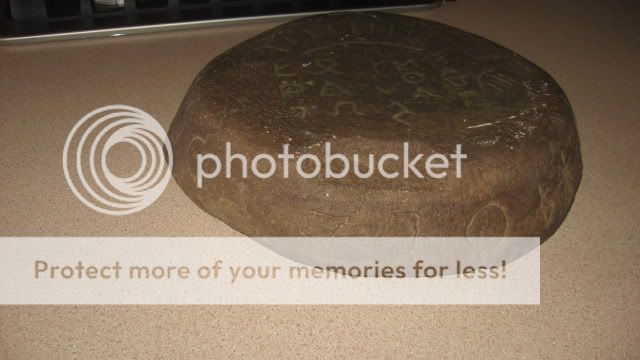
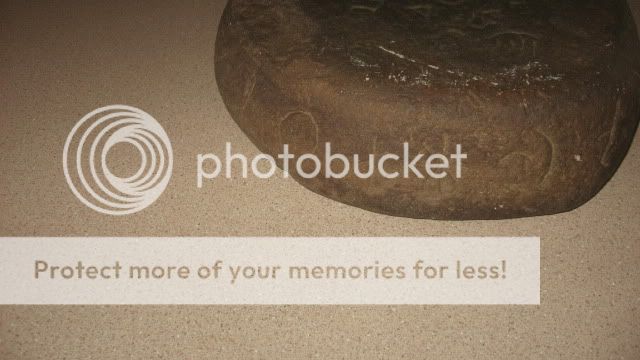
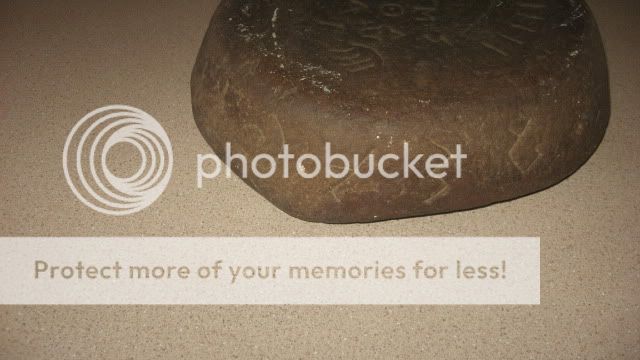
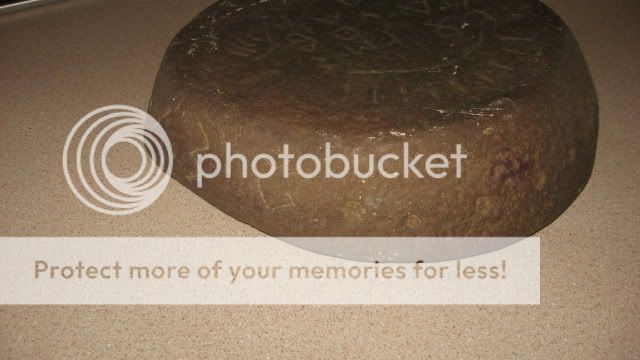
Thanks for your patience. As requested...here are some additional photos of the characters along the side (rim) of this bowl. I hope this helps. -TAT






reply to post by IAMTAT
Thank you, TAT, very much appreciated. I'm at work all day, so I'll take a closer look this evening. I'll post up later what I have so far as a translation. (sorry, no time machine.)
Thank you, TAT, very much appreciated. I'm at work all day, so I'll take a closer look this evening. I'll post up later what I have so far as a translation. (sorry, no time machine.)
reply to post by Druid42
You're welcome. Sorry for the delay...P.S. Loved the Hillbilly Hubcap Hoaxer narrative : )
You're welcome. Sorry for the delay...P.S. Loved the Hillbilly Hubcap Hoaxer narrative : )
reply to post by Byrd
Hello. Your posting prompted me to go back and dig into my papers and receipts for info on the purchase of this bowl (I have been collecting antiquities for some time). I was able to find the notes I made and the wire transfer form. Please forgive me for initially posting that it was through a NYC dealer...I had this confused with another piece I purchased.
Paid: $1200.00
To:
Mr. Andreas Bu---- ( He may be the contact or attorney for the owner)
Hamburg, Germany
---I really do not feel comfortable posting his complete address online.
Hello. Your posting prompted me to go back and dig into my papers and receipts for info on the purchase of this bowl (I have been collecting antiquities for some time). I was able to find the notes I made and the wire transfer form. Please forgive me for initially posting that it was through a NYC dealer...I had this confused with another piece I purchased.
Paid: $1200.00
To:
Mr. Andreas Bu---- ( He may be the contact or attorney for the owner)
Hamburg, Germany
---I really do not feel comfortable posting his complete address online.
Originally posted by Druid42
I'm pretty sure the piece was acquired at an auction, but I'd have to re-read to prove that. As a study of ancient scripts, I am waiting on more detailed pics to be provided of the rim symbols on that particular item, and IAMTAT, who has the piece, has promised them, but he is busy in THIS thread, and it's getting more attention than this one is. I am patient.
As far as the inscriptions go, It's a hodge-podge of Etruscan, Dalecarlian, and Futharck runes, with about 5 that are unidentifiable. That's all I can say for now.
I'm shocked that you venture it's a fake piece.
This comment wasn't made lightly. There's a couple of things that are "off" about it, which is why I asked about the dealer. Generally, the "high end" dealers (Southeby's, for instance) have some sort of provenance when they sell an ancient piece -- either a statement from the original owner OR a report from an archaeologist or something. So a reputable firm will include "papers" indicating where it came from, how it was obtained, and so forth, with the sale. That's been a "standard" practice in the antiquities field for at least the past 50 years.
Here's an example of an ancient bowl with provenance from Christie's:
www.christies.com...
In addition to looking through my books, I also did research on the cultures of the area and how their bowls were made to find out what this bowl was most similar to. I can't say my methods are 100% accurate and I didn't find everything, but I considered technology and cultures ranging from the Chacolithic (stone age) period through the Vikings (1100 AD) and medieval alchemists. I looked at the Middle East, Russia, Germany, Austria, Assyria, Netherlands, Finnland, Sweden, Thrace, Greece, Egypt, and so forth.
I also looked at basalt bowls and cups (the links I am giving are just ONE example site out of the dozens of each categories I looked through) :
data.bishopmuseum.org...
Bowls have different shapes according to their function AND the level of technology of the culture. This is moderately deep with a flattened bottom, Stone cooking pots are deeper, as a rule. Stone dishes are always much thinner and smaller. Stone cosmetic pots are much smaller. I spent some time looking up ceremonial bowls such as the Babylonian "demon trap" bowls: www.edgarlowen.com...
You can see that the earliest Egyptian stone bowls are different -- they're not as well carved as this bowl is (thicker rims, less shaping of the bowl) :
www.bu.edu...
The bowl is improperly shaped for a mortar for grinding herbal medicines and the wrong shape for grinding corn or wheat or nuts:
www.123rf.com...
It's about the right size for a brazier (www.metmuseum.org...) but without some sort of examination of the interior (it's not obviously fire blackened), that's hard to say. It's not as well carved as I'd expect from a brazier (the gods got only the very best) from an ancient Greek/Roman/Etruscan/Babylonian/Jewish/etc temple. It bears a slight resemblance to some of the stone bowls used by Vikings in blood rituals, but the walls are a bit too thick and it's rather ambitiously big for one of those.
Closer in form are the Aztec molcajetes -- but you say it comes from Europe, and the symbols certainly aren't Aztec (nor is the form... I'm looking at the thickness of the walls and the way the stone is worked) :
www.mexicolore.co.uk...
As to the symbols -- they don't show the pattern characteristics of words (language), though they do have some some elements in common with Gnostic symbols of the first millennium (see this example: www.edgarlowen.com... ) Symbols-as-writing are not unusual, particularly in Gnostic objects or alchemical objects.
Alas, "symbols as writing" are also VERY common in faked inscriptions.
So that's why I'm cautious about it and why I asked about provenance.
Originally posted by IAMTAT
reply to post by Byrd
Hello. Your posting prompted me to go back and dig into my papers and receipts for info on the purchase of this bowl (I have been collecting antiquities for some time). I was able to find the notes I made and the wire transfer form. Please forgive me for initially posting that it was through a NYC dealer...I had this confused with another piece I purchased.
Paid: $1200.00
To:
Mr. Andreas Bu---- ( He may be the contact or attorney for the owner)
Hamburg, Germany
---I really do not feel comfortable posting his complete address online.
So what was the information that you were given about this? I see a number of reputable antiquities dealers in Hamburg. Europe has quite a few antiquities which have been passed through family hands, so there should be a history to go along with it. (forgive me if you've posted this and I just missed the post.)
reply to post by Byrd
I was told it was originally unearthed from an excavation in Chersones (Crimea).
I was told it was originally unearthed from an excavation in Chersones (Crimea).
Originally posted by bulla
bard
What makes you think the inscriptions are new, can you you elaborate further, as to what leads you to that assumption,
The fact that the technology of the bowl and the technology of the symbols don't match. It's like someone showing you an "ancient artifact" made up of a Roman wooden cart and a Ford "Model T" engine. If you have technology that can inscribe symbols (symbols involving curves or circles) into a stone bowl, then you have the technology to shape a beautiful bowl -- symmetric, even surfaced, perfectly flat bottom and rim, beveled rims, and so forth.
The mish-mash of symbols also indicate that it's not language. I certainly agree that some of those are the Futhark runes and others appear to be from the Magical Alphabet of the Alchemists, but they're in the wrong context. Alchemists did transmit coded instructions to each other, but the codes and writing are well known (they wanted to share knowledge but in a way that others couldn't easily read it.)
I have read (and seen) alchemical texts (some of the old ones.) That ain't it.
reply to post by Byrd
Also...Please note in the most recent series of photos, the purple ink stamp, visible on the side of the bowl.
Also...Please note in the most recent series of photos, the purple ink stamp, visible on the side of the bowl.
So...
What if this piece is simply made by someone not so skilled and just practicing?...Just because certain skills exist in a given time period doesn't mean everyone has mastered them
As to a mix of characters... there is another bowl around from Bolivia that has mixed characters from several languages, including cuneiform
Not every find fits into a nice perfect niche like archaeologists would like... sometimes there are ooparts. And sometimes pictures on walls don't have religious significance and are simply doodles made by people bored and stuck in a cave during the winter
The Fuente Magna of Pokotia Bolivia
www.world-mysteries.com...
Picture mosaic of rim
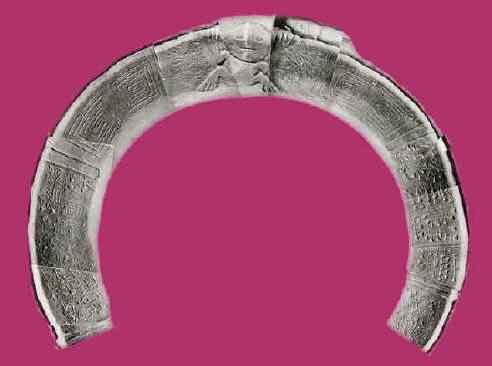
FULL SIZE
What if this piece is simply made by someone not so skilled and just practicing?...Just because certain skills exist in a given time period doesn't mean everyone has mastered them
As to a mix of characters... there is another bowl around from Bolivia that has mixed characters from several languages, including cuneiform
Not every find fits into a nice perfect niche like archaeologists would like... sometimes there are ooparts. And sometimes pictures on walls don't have religious significance and are simply doodles made by people bored and stuck in a cave during the winter
The Fuente Magna of Pokotia Bolivia
A large stone vessel, resembling a libation bowl, and now known as the Fuente Magna, was originally discovered in a rather casual fashion by a country peasant from the ex-hacienda CHUA, property of the Manjon family situated in the surrounding areas of Lake Titicaca about 75/80 km from the city of La Paz. The site where it was found has not been subject to investigation until recently. The Fuente Magna has not been shown in Bolivia until year 2000. It was considered false, until we began the investigations. The Fuente Magna was found The piece in question is a little out of place. It is beautifully engraved in chestnut-brown both inside and out. It reveals zoological motifs and anthropomorphic characters within.
www.world-mysteries.com...
Picture mosaic of rim

FULL SIZE
edit on 1-12-2011 by zorgon because: (no reason
given)
Explanation: Could this possibly be a Rosetta Stone [wiki] in a bowl format?
Personal Disclosure: Amazing bowl regardless of providence!
Personal Disclosure: Amazing bowl regardless of providence!
One of my team, also an archaeologist has this to say...
Poasted by 1Worldwatcher
To me it looks as if it is a form of Ancient Phoenician text. Though they did have symbols for complete words, it would be applicable for them to be just that, "Phoenician" the similarities are very close, but some of the symbols are not listed as recognizable letters of their alphabet.
After looking into this farther Zorgon, I can pretty much say it is Phoenician, but there are some symbols that look almost Egyptian in their form. Here is a website that has even more illustrations and alphabet info and may hold the answer to the signs/symbols we are seeing.
phoenicia.org...
Originally posted by IAMTAT
reply to post by Byrd
I was told it was originally unearthed from an excavation in Chersones (Crimea).
That would make it Greek, then en.wikipedia.org... -- quite possibly it's an old piece from an old excavation. Sadly, there's a HUGE number of possibilities for origin of this piece.
Cultures include:
Neolithic Cucuteni-Trypillian Culture - about 4500–3000 BC.
Sredny Stog Culture
Catacomb Culture about 2000 BC
Dacians
Cimmerians
Scythians (750-250 BC)
Sarmatians
Greek and Roman until the 3rd century, when you get the Goths.
The stonework isn't sophisticated enough for Greek/Roman/etc.
I'm still of the opinion that the inscription was added much later.
The inscription isn't Linear-B; www.omniglot.com...
And it isn't Egyptian (hieratic or demotic... demotic looks like this: oi.uchicago.edu... )
It's not Greek (some of those letters don't exist in Greek)
It's not Phoenecian or Paleo-Hebrew (en.wikipedia.org...)
It's not Roman.
It *does* have some elements of the Gothic script, but that wasn't developed until 400AD:
en.wikipedia.org...
I'm still leaning toward "new inscription (past 200 years or so)."
Originally posted by zorgon
What if this piece is simply made by someone not so skilled and just practicing?...Just because certain skills exist in a given time period doesn't mean everyone has mastered them
I considered that. One of the Bast amulets I own is very clearly done by the hand of an apprentice, and a not very skilled one.
As to a mix of characters... there is another bowl around from Bolivia that has mixed characters from several languages, including cuneiform
Hasn't that one been proven to be a modern fraud? I have a vague memory that it was, but could be mistaken.
Not every find fits into a nice perfect niche like archaeologists would like... sometimes there are ooparts. And sometimes pictures on walls don't have religious significance and are simply doodles made by people bored and stuck in a cave during the winter
ROFL! Every archaeologist who works in the field is familiar with the work of apprentices, bored people, and craftsmen! And graffiti. A number of folks specialize in this kind of art. But cultures have patterns because of technology.
In any case, this is an interesting piece, isn't it? I'm having fun trying to chase down what the possibilities are.
reply to post by zorgon
I have to agree with your archeologist friend...The similarities to Phoenician definitely appear to be there.
I have to agree with your archeologist friend...The similarities to Phoenician definitely appear to be there.
reply to post by zorgon
I have to say I am impressed with what resources that can be assembled for discovery, a great resource, and the remark re Rosetta stone may not be as farcical as one may imagine,re my utu byrd some weeks ago, re the eye of Horus, and the payment of two double sided gold coins, for the making of the snakes (serpents), for the beautification of the lands of Horus, being the making of rain,
Further to the bowl, it is my belief it is Alchemy, and I say its read in a vertical format, it the bowl is used by the practitioner , at sunrise, while it shows no signs of being upon fire, it is meant to be used on a fire, the reason for its robust and heavy construction, to resist cracking when heated, the entire purpose is for the making of steam ,mist
Hydro H2o@ Atomic(6) , as to why, I have vast knowledge,on this subject, some I have outlined on this thread,
To this I add, it is a new virgin rediscovery,of a much older, and much higher level of physics, than we are yet to fully understand, or should I say to except exists, that the Ancients were far in advance of to today, and that, that bowl given its alchemy, is to access another dimension, as can be seen depicted, King Solomans Temple at the entrance to it, standing on a pedestal, with steam and or mist clearly shown coming from the bowl, and behind is positioned the Ark of covenant,
Further the Alchemy, involved, is also that of both Mayan and Egyptian Pyramids Giza etc , I further add that, where ever there is or was Pyramid, there had to be an ARK of covenant
I have to say I am impressed with what resources that can be assembled for discovery, a great resource, and the remark re Rosetta stone may not be as farcical as one may imagine,re my utu byrd some weeks ago, re the eye of Horus, and the payment of two double sided gold coins, for the making of the snakes (serpents), for the beautification of the lands of Horus, being the making of rain,
Further to the bowl, it is my belief it is Alchemy, and I say its read in a vertical format, it the bowl is used by the practitioner , at sunrise, while it shows no signs of being upon fire, it is meant to be used on a fire, the reason for its robust and heavy construction, to resist cracking when heated, the entire purpose is for the making of steam ,mist
Hydro H2o@ Atomic(6) , as to why, I have vast knowledge,on this subject, some I have outlined on this thread,
To this I add, it is a new virgin rediscovery,of a much older, and much higher level of physics, than we are yet to fully understand, or should I say to except exists, that the Ancients were far in advance of to today, and that, that bowl given its alchemy, is to access another dimension, as can be seen depicted, King Solomans Temple at the entrance to it, standing on a pedestal, with steam and or mist clearly shown coming from the bowl, and behind is positioned the Ark of covenant,
Further the Alchemy, involved, is also that of both Mayan and Egyptian Pyramids Giza etc , I further add that, where ever there is or was Pyramid, there had to be an ARK of covenant
reply to post by bulla
Given the wisdom of those here, there is a set of Glyphs I am am searching for, there are three symbols in all, but the give away, is one shows a depiction of the pyramid with a large water tank upon it tip , thought to be published some 14 years ago National Geographic s or Readers digest or similar
These Glyphs are indeed very important, and I would be grateful if anyone remembers them or can lead me to them, as these Glyphs are the dashboard for the Pyramid, and I can fully explain and decode them, on there appearance, my self I have viewed them but have lost there existance
Given the wisdom of those here, there is a set of Glyphs I am am searching for, there are three symbols in all, but the give away, is one shows a depiction of the pyramid with a large water tank upon it tip , thought to be published some 14 years ago National Geographic s or Readers digest or similar
These Glyphs are indeed very important, and I would be grateful if anyone remembers them or can lead me to them, as these Glyphs are the dashboard for the Pyramid, and I can fully explain and decode them, on there appearance, my self I have viewed them but have lost there existance
Originally posted by bulla
reply to post by bulla
Given the wisdom of those here, there is a set of Glyphs I am am searching for, there are three symbols in all, but the give away, is one shows a depiction of the pyramid with a large water tank upon it tip , thought to be published some 14 years ago National Geographic s or Readers digest or similar
These Glyphs are indeed very important, and I would be grateful if anyone remembers them or can lead me to them, as these Glyphs are the dashboard for the Pyramid, and I can fully explain and decode them, on there appearance, my self I have viewed them but have lost there existance
Perhaps to further explain, the said magazine that at that time, was of the size of a National Geographic s magazine, and that the articular showing the depiction of the three symbols, stated that they were from upon, or from within the walls of a pyramid, and that they the symbols were at that time, the meaning of which were unknown
Or photographs, of unknown symbol's from within the pyramids, I can tell there is no hokes, as shortly after I discovered the true meanings, of those symbols
new topics
-
So I saw about 30 UFOs in formation last night.
Aliens and UFOs: 1 hours ago -
Do we live in a simulation similar to The Matrix 1999?
ATS Skunk Works: 2 hours ago -
BREAKING: O’Keefe Media Uncovers who is really running the White House
US Political Madness: 3 hours ago -
Biden--My Uncle Was Eaten By Cannibals
US Political Madness: 4 hours ago -
"We're All Hamas" Heard at Columbia University Protests
Social Issues and Civil Unrest: 4 hours ago -
The good, the Bad and the Ugly!
Diseases and Pandemics: 5 hours ago -
Russian intelligence officer: explosions at defense factories in the USA and Wales may be sabotage
Weaponry: 8 hours ago -
African "Newcomers" Tell NYC They Don't Like the Free Food or Shelter They've Been Given
Social Issues and Civil Unrest: 9 hours ago -
Russia Flooding
Fragile Earth: 10 hours ago -
MULTIPLE SKYMASTER MESSAGES GOING OUT
World War Three: 11 hours ago
top topics
-
BREAKING: O’Keefe Media Uncovers who is really running the White House
US Political Madness: 3 hours ago, 17 flags -
Biden--My Uncle Was Eaten By Cannibals
US Political Madness: 4 hours ago, 15 flags -
African "Newcomers" Tell NYC They Don't Like the Free Food or Shelter They've Been Given
Social Issues and Civil Unrest: 9 hours ago, 12 flags -
Elites disapearing
Political Conspiracies: 17 hours ago, 11 flags -
Pro Hamas protesters at Columbia claim hit with chemical spray
World War Three: 14 hours ago, 11 flags -
Two Serious Crimes Committed by President JOE BIDEN that are Easy to Impeach Him For.
US Political Madness: 12 hours ago, 7 flags -
911 emergency lines are DOWN across multiple states
Breaking Alternative News: 12 hours ago, 6 flags -
A Personal Cigar UFO/UAP Video footage I have held onto and will release it here and now.
Aliens and UFOs: 17 hours ago, 5 flags -
Russia Flooding
Fragile Earth: 10 hours ago, 5 flags -
Former NYT Reporter Attacks Scientists For Misleading Him Over COVID Lab-Leak Theory
Education and Media: 14 hours ago, 5 flags
active topics
-
Two Serious Crimes Committed by President JOE BIDEN that are Easy to Impeach Him For.
US Political Madness • 12 • : PorkChop96 -
Candidate TRUMP Now Has Crazy Judge JUAN MERCHAN After Him - The Stormy Daniels Hush-Money Case.
Political Conspiracies • 327 • : matafuchs -
BREAKING: O’Keefe Media Uncovers who is really running the White House
US Political Madness • 6 • : 19Bones79 -
Gotta watch - Israeli Comedy Show Mocking American College Students Supporting Hamas
Education and Media • 11 • : FlyersFan -
Do we live in a simulation similar to The Matrix 1999?
ATS Skunk Works • 8 • : SideEyeEverything1 -
Russian intelligence officer: explosions at defense factories in the USA and Wales may be sabotage
Weaponry • 150 • : andy06shake -
"We're All Hamas" Heard at Columbia University Protests
Social Issues and Civil Unrest • 40 • : ImagoDei -
Revolution in advertising: the Russians launched a unique satellite
Science & Technology • 72 • : BeyondKnowledge3 -
MULTIPLE SKYMASTER MESSAGES GOING OUT
World War Three • 17 • : RickyD -
The Acronym Game .. Pt.3
General Chit Chat • 7723 • : CCoburn


